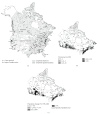Climate change and malaria in Canada: a systems approach
- PMID: 19277107
- PMCID: PMC2648659
- DOI: 10.1155/2009/385487
Climate change and malaria in Canada: a systems approach
Abstract
This article examines the potential for changes in imported and autochthonous malaria incidence in Canada as a consequence of climate change. Drawing on a systems framework, we qualitatively characterize and assess the potential direct and indirect impact of climate change on malaria in Canada within the context of other concurrent ecological and social trends. Competent malaria vectors currently exist in southern Canada, including within this range several major urban centres, and conditions here have historically supported endemic malaria transmission. Climate change will increase the occurrence of temperature conditions suitable for malaria transmission in Canada, which, combined with trends in international travel, immigration, drug resistance, and inexperience in both clinical and laboratory diagnosis, may increase malaria incidence in Canada and permit sporadic autochthonous cases. This conclusion challenges the general assumption of negligible malaria risk in Canada with climate change.
Figures




References
-
- Parry M, Canziani O, Palutikof J, van der Linden P, Hanson C, editors. Climate Change 2007: Impacts, Adaptation and Vulnerability. Cambridge, UK: Cambridge University Press; 2007. (Working Group II Contribution to the Fourth Assessment Report of the Intergovernmental Panel on Climate Change).
-
- McMichael AJ, Campbell-Lendrum DH, Corvalán CF, et al., editors. Climate Change and Human Health: Risks and Responses. Geneva, Switzerland: World Health Organization; 2003.
-
- McMichael A, Campbell-Lendrum DH, Kovats RS, et al. Climate change. In: Ezzati M, Lopez A, Rodgers A, Vander Hoorn S, Murray C, editors. Comparative Quantification of Health Risks: Global and Regional Burden of Disease Due to Selected Major Risk Factors. Geneva, Switzerland: World Health Organization; 2004. pp. 1543–1649.
-
- McMichael AJ, Woodruff RE, Hales S. Climate change and human health: present and future risks. The Lancet. 2006;367(9513):859–869. - PubMed
LinkOut - more resources
Full Text Sources

